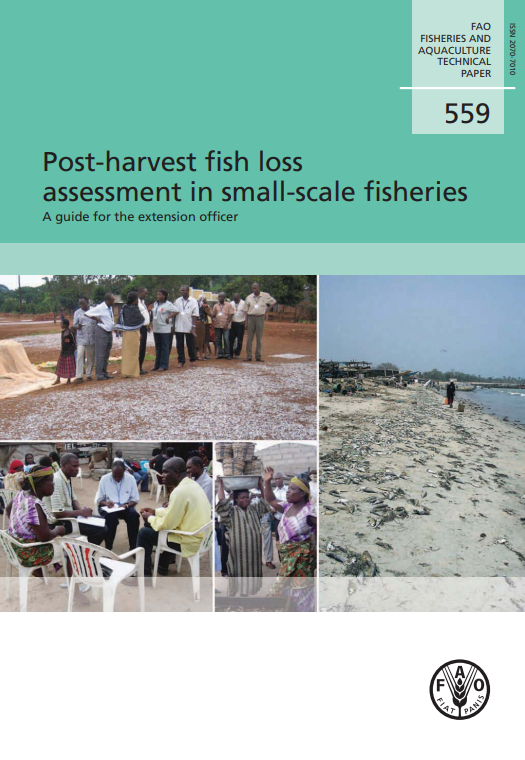
| Judul | Post-harvest fish loss assessment in small-scale fisheries : a guide for the extension officer / Yvette Diei-Ouadi, Yahya I. Mgawe; Food and Agriculture Organization |
| Pengarang | DIEI-OUADI, Yvette Food and Agriculture Organization MGAWE, Yahya I. |
| Penerbitan | Rome : Food and Agriculture Organization, 2011 |
| Deskripsi Fisik | x, 93 p. :ill. ;25 cm. |
| ISBN | ISBN 978-92-5-106880-9 |
| ISSN | 2070-7010 ISBN 978-92-5-106880-9 |
| Subjek | FISHES CATCHING DATA FISHERIES POSTHARVEST LOSSES EXTENSION ACTIVITIES FISHERY DATA |
| Abstrak | The field activities within the regional post-harvest loss assessment programme in small-scale fisheries in Africa (an FAO regular programme conducted from 2006 to 2008) tested and validated three key fish loss assessment methodologies that have been developed over the past two decades: the Informal Fish Loss Assessment Method (IFLAM), Load Tracking (LT) and the Questionnaire Loss Assessment Method (QLAM). This manual describes these three methods in detail and provides practical guidelines on when they can be used and on how to use them to collect reliable data, be it for planning for an intervention to reduce losses in a particular area or at the country level or monitoring and assessing the effectiveness of a loss reduction intervention. While the IFLAM is used to generate qualitative and indicative quantitative post-harvest fish loss data that can be used to inform decision-making or to plan the use of LT and the QLAM, the latter are quantitative assessment methods. Load Tracking is used to quantify losse |
| Catatan | Judul seri: FAO Fisheries and Aquaculture Technical Paper, no. 559, 2011. Bibl.: p. 77. Annex : p. 79-93 |
| Bentuk Karya | Tidak ada kode yang sesuai |
| Target Pembaca | Tidak ada kode yang sesuai |
| Lokasi Akses Online | https://www.fao.org/4/i2241e/i2241e00.htm |
| Tag | Ind1 | Ind2 | Isi |
| 001 | INLIS000000000000463 | ||
| 005 | 20250210034226 | ||
| 008 | 250210################|##########|#|## | ||
| 020 | # | # | $a ISBN 978-92-5-106880-9 |
| 022 | # | # | $a 2070-7010 |
| 022 | # | # | $a ISBN 978-92-5-106880-9 |
| 035 | # | # | $a 0010-1118000463 |
| 082 | # | # | $a 639.2 |
| 084 | # | # | $a Sr. FAO 639.2 |
| 100 | 1 | # | $a DIEI-OUADI, Yvette |
| 110 | # | # | $a Food and Agriculture Organization |
| 245 | 1 | # | $a Post-harvest fish loss assessment in small-scale fisheries : a guide for the extension officer /$c Yvette Diei-Ouadi, Yahya I. Mgawe; Food and Agriculture Organization |
| 260 | # | # | $a Rome :$b Food and Agriculture Organization,$c 2011 |
| 300 | # | # | $a x, 93 p. : $b ill. ; $c 25 cm. |
| 500 | # | # | $a Judul seri: FAO Fisheries and Aquaculture Technical Paper, no. 559, 2011.-- Bibl.: p. 77.-- Annex : p. 79-93 |
| 520 | # | # | $a The field activities within the regional post-harvest loss assessment programme in small-scale fisheries in Africa (an FAO regular programme conducted from 2006 to 2008) tested and validated three key fish loss assessment methodologies that have been developed over the past two decades: the Informal Fish Loss Assessment Method (IFLAM), Load Tracking (LT) and the Questionnaire Loss Assessment Method (QLAM). This manual describes these three methods in detail and provides practical guidelines on when they can be used and on how to use them to collect reliable data, be it for planning for an intervention to reduce losses in a particular area or at the country level or monitoring and assessing the effectiveness of a loss reduction intervention. While the IFLAM is used to generate qualitative and indicative quantitative post-harvest fish loss data that can be used to inform decision-making or to plan the use of LT and the QLAM, the latter are quantitative assessment methods. Load Tracking is used to quantify losses at stages along the distribution chain or losses related to specific activities, such as fishing, transport, processing and marketing. Key data related to the cause and effects of losses from an IFLAM study are validated using the QLAM before any suitable intervention is introduced. A combination of the IFLAM, LT and QLAM could then be used to monitor and evaluate the effects of an intervention. Illustrative examples and case studies are presented to facilitate the uptake and use of the methods in systematic fish loss assessment. This fieldwork tool also enlightens the extension officer on how to communicate the data from the assessments and the design of loss reduction interventions to help policy-planners and decision-makers understand important issues facing fishing communities. It is hoped that this manual will be of interest to all those involved in fisheries technology and development, field research, data analysis and reporting as well as participatory approaches to development. |
| 650 | # | 4 | $a CATCHING DATA |
| 650 | # | 4 | $a EXTENSION ACTIVITIES |
| 650 | # | 4 | $a FISHERIES |
| 650 | # | 4 | $a FISHERY DATA |
| 650 | # | 4 | $a FISHES |
| 650 | # | 4 | $a POSTHARVEST LOSSES |
| 700 | 1 | # | $a MGAWE, Yahya I. |
| 856 | # | # | $a https://www.fao.org/4/i2241e/i2241e00.htm |
| 990 | # | # | $a 96/FAO/2012 |
| No | Nama File | Nama File Format Flash | Format File | Action |
| 1 | FAO_i2241e.pdf | FAO | Baca Online |
Content Unduh katalog
Karya Terkait :